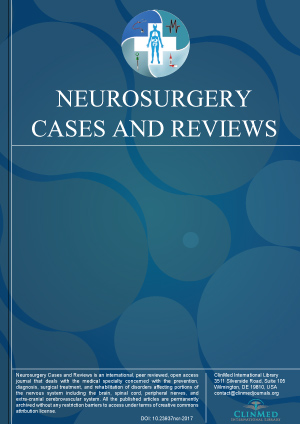Archive
Open Access DOI:10.23937/2643-4474/1710151
Giant Intracranial Epidermoid Tumour: Decision Making in a Complex Case
Nicholas G Candy and Stephen Santoreneos
Article Type: Case Report | First Published: 2023/12/15
Article Formats
- Full Article
- XML
- EPub Reader
Open Access DOI:10.23937/2643-4474/1710150
Ming-Sheng Lim, Catherine Moran and Alan Beausang
Article Type: Case Report | First Published: 2023/12/14
Article Formats
- Full Article
- XML
- EPub Reader
Open Access DOI:10.23937/2643-4474/1710149
Kevin Jonathan Sjukur, Andi Asadul Islam, Andi Ihwan, Rais Al-'Abqary and Nailul Humam
Article Type: Case Report | First Published: 2023/11/16
Article Formats
- Full Article
- XML
- EPub Reader
Open Access DOI:10.23937/2643-4474/1710148
Haman Nassourou Oumarou, Bello Figuim, Ndome Toto Orlane, Baboke Indira, Nzedzou MG and Djientcheu Vincent De Paul
Article Type: Case Report | First Published: 2023/11/16
Article Formats
- Full Article
- XML
- EPub Reader
Open Access DOI:10.23937/2643-4474/1710147
Vishnu A Suresh, MBChB
Article Type: Case Series | First Published: 2023/11/16
Article Formats
- Full Article
- XML
- EPub Reader
Open Access DOI:10.23937/2643-4474/1710146
Ahmed Muthana, Zahraa A Alsubaihawi, Ali Adnan Dolachee, Mustafa E Almurayati, Oday Atallah, Mustafa Ismail and Samer S Hoz
Article Type: Case Report | First Published: 2023/10/11
Article Formats
- Full Article
- XML
- EPub Reader
Open Access DOI:10.23937/2643-4474/1710145
Lorena Broseghini Barcelos, MD, MSc, Murilo Martinez Marinho, MD, MSc, Tamine Capato, PT, PhD, Leonardo Furtado Freitas, MD, Vanderci Borges, MD, PhD and Henrique Ballalai Ferraz, MD, PhD
Article Type: Case Report | First Published: 2023/10/11
Article Formats
- Full Article
- XML
- EPub Reader
Open Access DOI:10.23937/2643-4474/1710144
Craniometric Analysis in Modern Peruvian Population
Christian A. Yataco-Wilcas, Bruno E. Diaz-Llanes, Yosimar S. Coasaca-Tito, Luis A. Lengua-Vega and Cristian E. Salazar-Campos
Article Type: Case Report | First Published: 2023/08/07
Article Formats
- Full Article
Open Access DOI:10.23937/2643-4474/1710143
Rupture of Developmental Venous Anomaly
Osama Bashawieh and Mohammed Bafaquh
Article Type: Case Report | First Published: 2023/07/26
Article Formats
- Full Article
- XML
- EPub Reader
Open Access DOI:10.23937/2643-4474/1710142
Tomohiro M Ko, Stephen A Johnson and Kant Matsuda
Article Type: Case Report | First Published: 2023/07/08
Article Formats
- Full Article
- XML
- EPub Reader
Open Access DOI:10.23937/2643-4474/1710141
Mustafa E Almurayati1, Saja A Albanaa, Salima B Alsaadi, Aktham O Al-Khafaji, Ali M Neamah, Rania Thamir Hadi, Mustafa Ismail and Samer S Hoz
Article Type: Case Series and Literature Review | First Published: 2023/07/08
Article Formats
- Full Article
- XML
- EPub Reader

Volume 6
Issue 2
Issue 2
